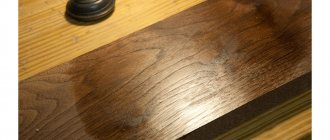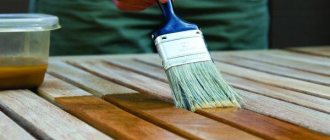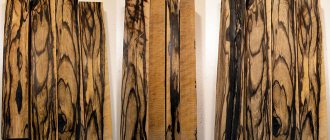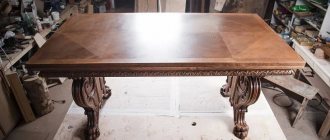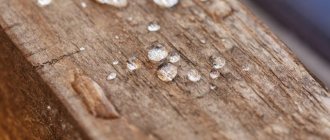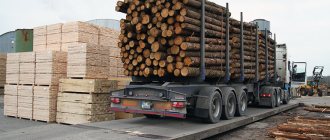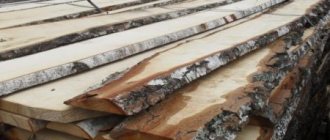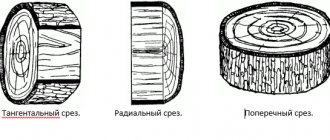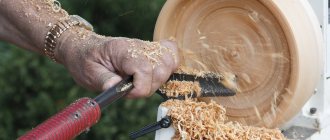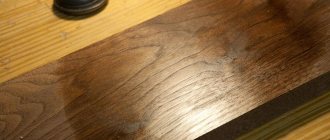Features of firing
Fire has always caused great damage to wood. It is capable of destroying wooden products in a matter of minutes. Exposure to an open flame changes the structure of wood. However, this does not always negatively affect its properties.
By controlling the impact of fire on wood, its characteristics can be improved. This was proven in practice back in ancient times. Our ancestors on different continents noticed that burnt wood increased its properties.
Treating wood with fire is an ancient technique that even has its own specific name - “Cedar Simmering”. It is believed that this method was invented on the Japanese islands. Although traces of firing of various wooden structures have been found on different continents. Thus, in the territory of Ancient Rus', open flame was used to treat roofs, doors, walls, floors, windows, pillars, and so on.
Doors after controlled exposure to fire Source bazafasada.ru
Now craftsmen also widely use the method of heat treatment of wood. Although not every homeowner is aware of this. Many people believe that it is reasonable and beneficial to use only varnish to protect wooden surfaces. However, it is a chemical substance. Therefore, low-quality varnish can release volatile compounds that are not always safe for people.
When direct, controlled firing of wood occurs, the fibers in the upper layer begin to narrow. In this case, the pores are filled with soot, as well as molten resin. Therefore, the surface is less negatively affected by the environment. It also reduces the number of bacteria.
Important! Heat treatment of a wooden surface with fire is a convenient way of protection. Craftsmen often burn wood with a gas torch. However, there are other ways. Regardless of the option, specialists additionally use fire-fighting agents. These are fire extinguishers and ordinary sand. However, they are rarely used. After all, the craftsmen know what type of wood is best to burn and how to carry out the process correctly in order to prevent the occurrence of any excesses.
Using a gas burner to burn a board Source ytimg.com
After closing the pores of the material, the hygroscopicity decreases. In addition, as a result of exposure to flame, all “germs” of rotting are destroyed. Burnt wood is of no interest to woodworms - beetles that are partial to wood sugar. After all, it burns out when exposed to fire.
Firing is the so-called smoking process. After its completion, the tree becomes even more beautiful lumber. It takes on a dark chocolate color with a silver tint. The material may also turn pitch black. With the help of heat treatment, it is possible to achieve a color that no other paint can achieve.
Burnt wood acquires a unique color and texture Source jurnalstroyka.ru
Advantages and disadvantages of firing
The process of wood processing using open fire and with strict adherence to technology has a number of advantages:
- simple to implement, does not require the preparation of complex equipment and can be performed outside a specially prepared room;
- there is no need to additionally use chemical compounds for protection;
- Wooden products and structures become more resistant to wear and damage by microorganisms.
Burnt wood can withstand open fire longer than its normal state. This is due to the destruction of hemicellulose formations, which are easily flammable because pyrolysis gases are formed during combustion.
The disadvantage of firing is the step-by-step process. After all, wood must not only be exposed to open fire. It still needs to be cleaned and processed.
Processing burnt boards Source ytimg.com
See also: Catalog of companies that specialize in finishing materials and related work
Decor
Decorative objects made of burnt wood will complete the picture:
- figurines;
- vases;
- candlesticks;
- photo frames;
- picture frames;
- wall decorations.
To make the decor look brighter and more elegant, it can be coated with a special transparent wood varnish.
Features and requirements for fired wood
In ancient times, people used coniferous wood for firing. Fire mainly affected pine and cedar. Spruce and larch were also subjected to heat treatment. Now they also prefer to burn the same rocks. After all, they have a soft structure. After exposure to an open flame, they produce a beautiful material with a variety of patterns. There will be no stains on it.
When treated with fire, maple and poplar create interesting elongated lines along the grain. In this case, birch becomes a material with low heat capacity. Thanks to this property, it does not burn the skin when heated.
If you decide to burn wood, then its quality does not matter. For such processing, you can use wood with knots. Their presence will even allow you to achieve a more effective result. A charred board will have dimples where it originally had soft fibers on its surface. If they had a rigid structure, then the material will become more prominent, and after cleaning it will acquire an expressive texture.
Wood with an unusual texture after firing Source pinimg.com
Important! Chipboard can also be treated with fire when the boards are covered with coniferous veneer. In this case, only dry wood is burned. Its importance should be no higher than 15%.
Finishing of burnt wood
After the wood has cooled, soot and soot are removed from it. For this purpose, brushes made of brass wire are used so as not to strip off excess. During mechanical processing, texturing or so-called artificial aging of wood can also be carried out.
Cleaned products can be installed immediately. Additional processing is needed not so much to protect the structure of the wood, but to preserve its color and overall appearance after years, as well as to eliminate soiling. For interior decoration, the lining is coated with linseed or hemp oil in several layers. Wood for facades and other external works is coated 1–2 times with colorless nitrocellulose varnish with the addition of synthetic wax: either with a brush along the grain or with a spray gun.
rmnt.ru
Types of firing
In the past, wood was burned by simply placing it in a fire. It was lit in the open air or in a stove. Now they use special equipment. It allows you to change the firing temperature. Therefore, it is possible to obtain different effects on wooden surfaces.
Options for wooden surfaces after contact with fire Source pinimg.com
Pedestrian paths
The durability and resistance of fire-treated wood allows it to be used for arranging garden paths, paths between plantings and picnic areas. The easiest way is to pave the sidewalk with wide boards or heavy bars, but you can do something more interesting.
If the surface is well protected from erosion, lay out a random pattern of burnt saw cuts of different diameters.
Features of the technology
The use of flame as a protective treatment for fresh wood allows you to remove all roughness from the surface. This process even replaces grinding. However, first, preparation is always carried out, during which branches, protrusions, dirt, and so on are removed from wooden blanks.
Burning with a blowtorch
The work is carried out with a blowtorch heated to the maximum. The flame from it is directed perpendicular to the wooden surface. The duration of exposure to fire directly depends on the thickness of the workpiece and the result to be obtained. However, firing is always performed evenly over the entire surface. It should acquire an even, expressive pattern. After this, grinding is carried out.
If you burn wood with a blowtorch as hot as possible and varnish it, then you will be able to get an aged wooden surface. Usually the process is performed separately for each board.
Blowtorch Source etsystatic.com
Stages of work
How to carry out firing at home can be seen using the example of using a standard burner. Let's look at the step-by-step processing of a wooden piece with a gas burner.
- The flame of the device must be kept calm, even, and bluish. But they don’t burn with yellow fire.
- To process the wood evenly, you need to run the tool over the surface several times . The movements should be the same as if the board was being painted with a brush. It is more convenient to start from the top. The burnt board should be burnt 4 mm deep.
- Use a brush or sander to walk along the grain of the wood, trying not to damage the structure of the material. At the same time, the flute is also used.
- The cleaning process (you need to be prepared for this) is very painstaking and time-consuming. The detached soot must be completely removed. If you ignore this point, the workpiece will not look beautiful.
- You can check the quality of the work you have done yourself: wipe the wood with a napkin and a soft cloth. To enhance the relief, you can once again use firing followed by brushing.
The result of this work is a relief surface, the shade of which can be from soft golden to rich chocolate. Sometimes a layer of aniline dye is placed on the surface.
How to process wood using Japanese pyrolysis technology.
- It is necessary to remove the top ash layer from the wood. The boards must be washed in water and then thoroughly soaked in vegetable oil. This will help the wood become moisture-repellent, with antiseptic characteristics.
- The finished material will become dark silver and shiny. In the old days, this effect was achieved by simply sending the wood into a stove or fire, but today they turn to a burner.
Japanese craftsmen who burned wooden surfaces this way protected houses from fires. The ash layer is not afraid of fire, therefore the Japanese firing method is optimal for objects and objects located on the street.
Processing a wooden product with a blowtorch is carried out with an extremely heated tool. The fire must be directed only perpendicular to the surface. How long to act depends on the workpiece and the final purposes of firing. All manipulations must be performed measuredly, without haste. The surface should gradually acquire contrast. Then the product is sanded, treated with drying oil or the same varnish.
Briefly about the main thing
Processing wood using an open flame eliminates the need to use fire retardants and antiseptics to protect the material. After firing, wood's hygroscopicity decreases and its resistance to wear and microorganisms increases. In addition, charred material is more difficult to ignite.
Nowadays such processing is carried out with a blowtorch or gas torch. Full, deep or shallow firing can be carried out. When implementing the first option, the wood dries out. For this purpose, vacuum furnace units are used, where the temperature reaches 400 ℃.
Often the wood is fired using modern Japanese technology. It allows you to get a deeply textured surface treated with tung oil.
Ratings 0
Wine Vault
Charring, as a method of processing wood, should be adopted by brewers and winemakers, because homemade strong drinks are perfectly stored in containers made from such material in the cellar.
Noble strong alcohol is infused in charred oak barrels: whiskey, cognac, rum. From this, the product acquires additional taste and aromatic qualities.
Is it possible to have a fire in a bathhouse?
Such emergency incidents are not uncommon. According to statistics, the sauna's embrace of flame is associated with the chimney. It requires regular cleaning. A fire happens if there is a lot of soot in it.
A fire in a bathhouse can also be caused by faulty electrical wiring. Sometimes the oven itself. It happens that people violate safety rules and a fire occurs. It is important what material the room is made of. It should insulate well.
Detailed information is visible in the video:

